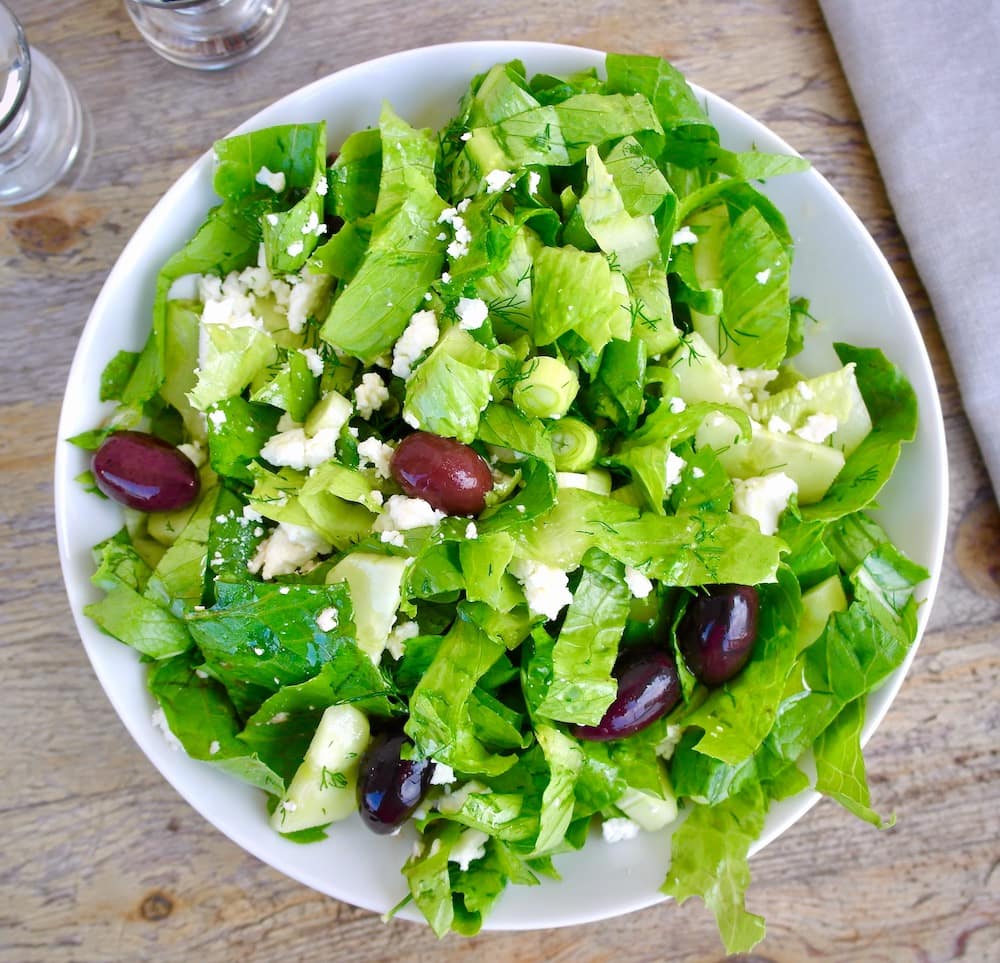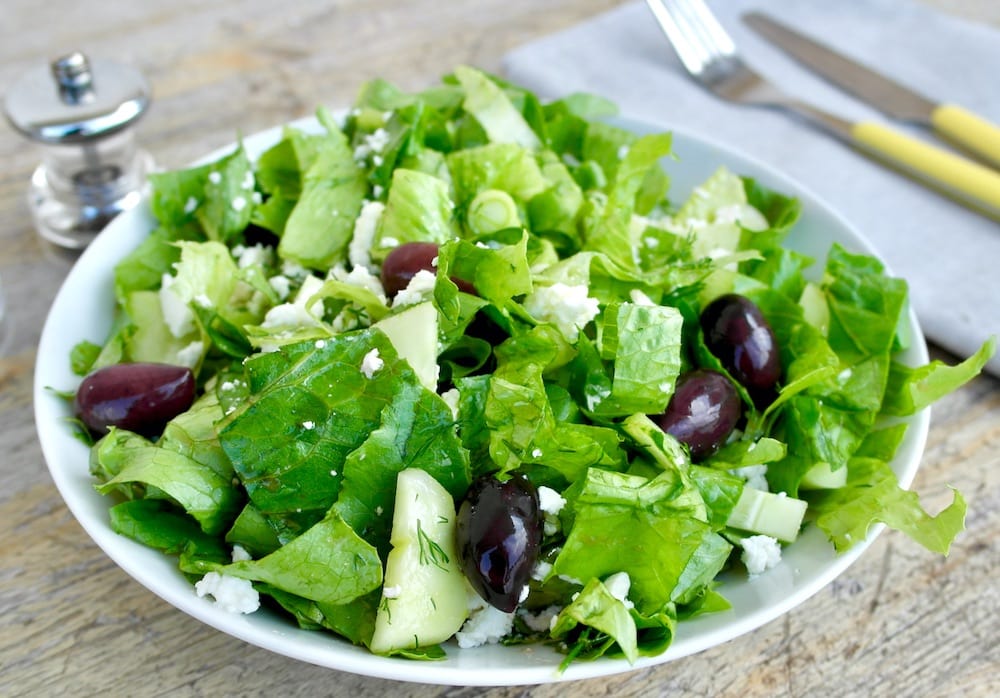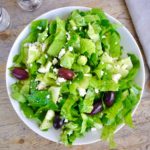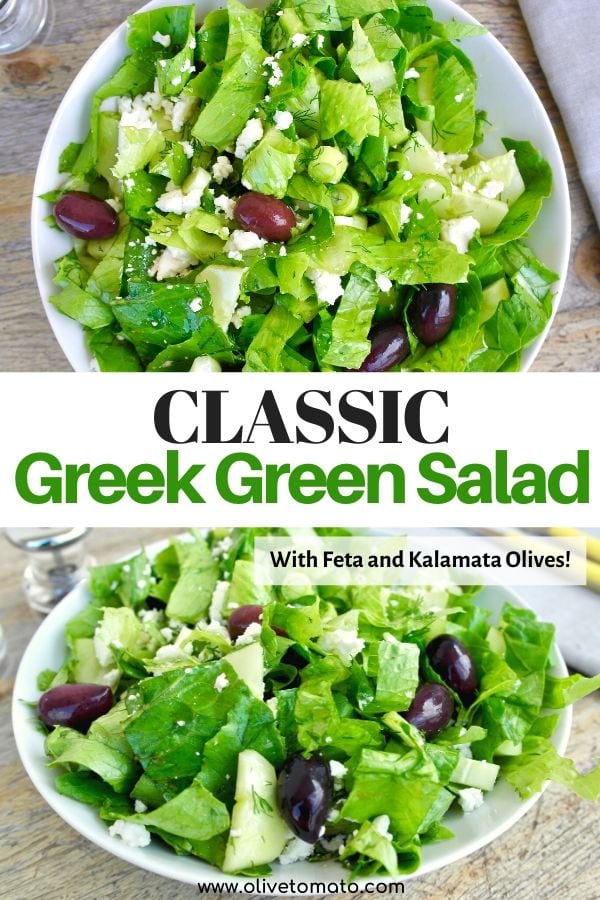Classic Greek Green Salad with Feta – Maroulosalata
One of the best Green salads you will ever have: Crispy romaine, feta, Kalamata olives, herbs and drizzled with extra virgin olive oil and a touch of lemon.

In Greece we have 3 main salads: The Greek salad (horiatiki), the one with tomatoes, cucumbers and feta, the cabbage and carrot salad (lahano) which is a winter salad made with cabbage and lemon, olive oil and a touch of garlic and then you have the classic green salad, which may be consumed year round but mostly in the colder months and is made with romaine, dill, olive oil and lemon (or vinegar).
Once summer is over and tomatoes are not that great anymore, the Green salad is the go-to salad. I don’t know what it is about this salad, but it is addictive. It’s this combination of spring onions and the dill, that makes it special, and when you add feta, well I could just eat it all. I particularly like this salad as an accompaniment to larger dinners with many other foods, because it works well as a side, especially with fish or pasta, as you can make as simple or as hearty as you like.
The basic version of this salad consists of romaine lettuce, spring onion, dill, olive oil and vinegar (or lemon juice). The enhanced version of the Greek green salad includes cucumbers, kalamata olives, crumbled feta and maybe some crushed rusks or homemade olive oil croutons. The enhanced version is what I make when the salad is the main meal. It is very filling, delicious and hearty. The basic version is ideal when you have other dishes on the table, and it is the version that you will get in most restaurants and taverns.
Nutritional Value of the Greek Green Salad
Romaine is not often considered a super nutritious green, but that is not true. It actually contains higher amounts of certain minerals than kale (using as a comparison as it is so popular), four times the amount of beta-carotene and higher amounts of vitamin K, potassium and folate. So, it’s all good, plus it is nice to eat, crunchy and not too bitter. By adding the olive oil, you will have a higher absorption of antioxidants from the salad, plus you are getting the good fat and an additional dose of antioxidants from the olive oil.

Make Ahead
Ok, so you cannot make this completely ahead of time as the salad will wilt and get soggy. So, I’ll wash the lettuce by letting it sit for a few minutes in a mixture of water and vinegar which helps loosen the dirt. I set aside in the refrigerator. I also wash the dill. You can also prepare the dressing ahead of time and keep it in a closed jar, but the lemon will retain more nutrients if you make it on the spot.
The rest I do right before serving.
Tips
- The dill is really important in this salad, it would appear that oregano would also go well, but it would give a different flavor profile.
- The same goes with spring onions, do not substitute with regular onions.
- The romaine should be in small pieces so that everything is mixed evenly.
- No garlic. Yes garlic is so good, but does not belong in this salad
Classic Greek Green Salad with Feta – Maroulosalata

Ingredients
- 1 medium head of romaine
- 2 cucumbers peeled and sliced
- 2-3 spring onions (white part)
- ½ cup chopped fresh dill
- 6-7 Kalamata olives
- ⅓ cup extra virgin olive oil
- 2-3 tbsp or juice of one lemon (or same amount of red wine vinegar)
- 4 ounces feta
- Salt as needed
Instructions
- Wash romaine lettuce and chop in bite size pieces, set aside
- Peel and slice cucumbers. If pieces are big, slice them in half.
- Slice thinly the white part of the spring onions.
- Chop dill
- Toss all 4 ingredients in a large bowl (lettuce, cucumber, dill and spring onions)
- Mix the olive oil with the lemon juice (or vinegar) and pour over salad, toss again. Sprinkle with some salt.
- If adding feta, olive or croutons, add them at the end and mix gently.
SAVE FOR LATER AND PIN IT!


Perfect! It’s the fresh dill flavor that does the trick!
Love this salad! So easy and flavorful.
I just love your posts and enjoy all these salads.I do have a problem getting fresh dill this time of year, any suggestions? I wish you and your family a blessed holiday season. Much gratitude for all you do.
Thank you Jean! Yes, you can use dry dill. Just mix it with the olive oil and lemon juice (step 6). I also freeze dill when I find it fresh. I’ll wash it and chop it and freeze it. Happy Holidays
Thank you so much for this recipe Elena! I just made this following your instructions to the letter. I had some leftover fresh dill on hand and didn’t know how to use it up. I will now buy fresh dill just so I can make this salad regularly. I love cooking with fresh herbs, but am not accustomed to adding them to raw green salads. I’ve been missing out! This is so easy to make, clean, fresh, and satisfying. The perfect antidote to the overindulgence that happens this time of year!
Thank you Amy! Yes herbs can really make a difference. Happy holidays!
I love to make a basic vinaigrette and then mash some Oregano and feta into it. Yum!
That sounds good Ashley!
I forget how much I enjoy salads until I read your posts☺Yes, the addition of spring onion and some feta is so good. I grew up eating salad with lemon and olive oil dressing so am biased saying it’s one of the best lol. Wishing you and your family a lovely festive season.
Thank you Eva! I’m glad! I think salads have a reputation of not being enjoyable. Have a great holiday season!
I agree this salad is addictive. Is this also called peasant salad?
Hi Patrick, No the more known Greek salad with the tomatoes and feta is also known as “horiatiki” which means village salad. This green salad is usually just ordered as “prasini” which means green in Greek.